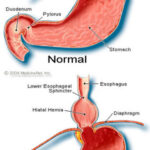I have a five centimeter hiatal hernia. I have bad acid reflux. I am one of those people who can’t tolerate acid reflux medications, and I may need surgery due to damage in my esophagus, constant acid reflux and overall discomfort.
A hiatal hernia is one of the most common forms of hernia, and it occurs in more than 50 percent of the population. People age 60 and older often have hernias, due to the weakening of the diaphragm muscle and stomach with age. But a hiatal hernia can affect people of all ages and can even be present at birth.
Hiatal hernias occur when part of the stomach protrudes into the diaphragm, causing a tear in the muscle. A small bulge, or tenderness may ensue, or the hernia may not cause troublesome symptoms. In fact, many people do not know they have a hernia, until symptoms develop. One of the most troublesome symptoms of hiatal hernia is pain, and acid reflux, or Gerd. This is a controversial subject, because there has not been direct proof that hiatal hernias are the cause of reflux, but they are considered a culprit behind the disease, especially if the hernia is large, say five centimeters or more, and if conventional acid reflux treatment doesn’t work.
People that have hernias and suffer from acid reflux are often prescribed acid suppressing drugs, such as the popular class of Proton Pump inhibitors. These include over-the-counter versions of Prilosec, Prescription Nexium, Prevacid, Aciphex, and more. Some people use H2 inhibitors, such as Zantac, and other over the counter antacids, like Tums or Pepcid AC.
When acid suppression therapy doesn’t work, or if a hiatal hernia becomes painful or strangulated in the diaphragm, often surgery is the last resort. A surgeon will make three to four small incisions in the stomach, use a laproscope and pull down the hernia out of the diaphragm. Sometimes a Nissan Fundoplication is performed. This involves wrapping part of the stomach around the lower esophagus to prevent acid from coming back up into the esophagus, and creates a natural barrier that the hernia disrupted. Success rates on this type of surgery vary depending on the surgeon, and recurrence rates. Some people need a second surgery, especially if the wrap comes undone, or is too tight.
Many people get hiatal hernias, and they are common among people who lift heavy objects for a living, or have naturally weakened stomach muscles. Sometimes they are hereditary, being present at birth, and made worse through exercise or age. Weight lifters can easily develop a hiatal hernia, and pregnant women can develop hernias and suffer heartburn symptoms throughout their pregnancy.
The best way to deal with a hiatal hernia, if not troublesome, is to maintain a healthy weight. The less pressure on one’s abdomen, the lessening of pain and reflux. If one has a big hiatal hernia, or are in danger of the hernia becoming strangulated, they should seek medical attention. If a hernia becomes strangulated, as in permanently stuck in place, it may cut of a person’s blood supply, leading to an emergency situation. If a person has a large hiatal hernia, and develops worsening or severe pain in the area, they should seek emergency medical attention immediately. Sometimes a hiatal hernia causes other misdiagnosed diseases, such as heart disease, but if a person feels chest pain, they should go to the emergency room just in case, for hiatal hernia pain can sometimes mimic a heart attack, or mask a genuine heart attack as well.
The esophagus can become diseased if a hiatal hernia causes reflux for prolonged periods of time. This includes continual acid reflux, which leads to a condition called esophagitis. This is reddening of the esophagus from its natural pink color, and can sometimes cause scarring, inflammation, ulcers, or Barrett’s esophagus, a possible precursor to esophagus cancer. People with hiatal hernias and Gerd often need to be monitored for progression of the disease, including periodic endoscopes to rule out cancer.
New methods have made hiatal hernia surgery more successful, and this includes the laproscopic surgery, and new forms of esophageal sphincter surgery, including sewing the esophagus muscle or Les tighter together, balloon type of techniques and more. Not all techniques work for everyone, and a sufferer must find a doctor who can pinpoint the exact cause of their symptoms, if possible. Tests to rule out Gerd include a PH monitoring test, where the amount of acid reflux coming up into the esophagus is tested over a 24-hour period, and a motility study, to see how food goes down the esophagus and empties from the stomach.
Alternative therapies that have showed promise for hiatal hernia include massage and acupuncture, but sometimes surgery is the only way to correct the internal problem, regardless of symptom relief.





